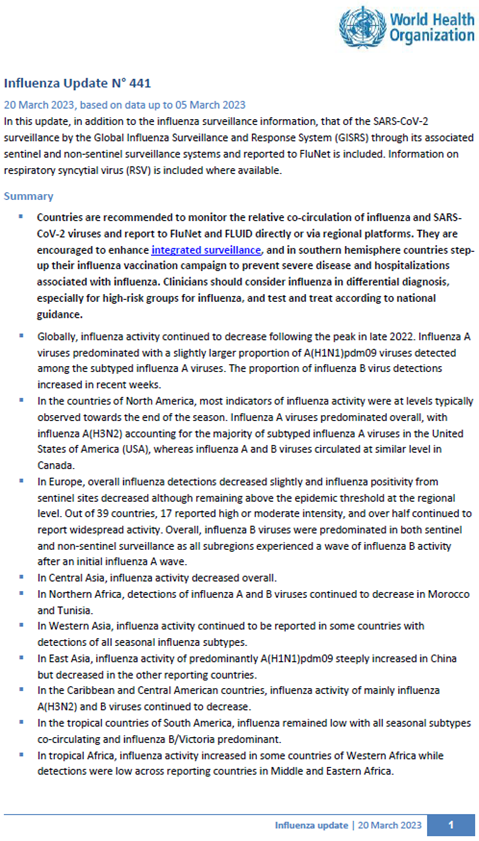Influenza Update N° 441

Overview
20 March 2023, based on data up to 05 March 2023
Information in this report is categorized by influenza transmission zones, which are geographical groups of countries, areas or territories with similar influenza transmission patterns. For more information on influenza transmission zones, see the link below:
Influenza Transmission Zones (pdf, 659kb)
- Countries are recommended to monitor the relative co-circulation of influenza and SARS-CoV-2 viruses and report to FluNet and FLUID directly or via regional platforms. They are encouraged to enhance integrated surveillance and in southern hemisphere countries step-up their influenza vaccination campaign to prevent severe disease and hospitalizations associated with influenza. Clinicians should consider influenza in differential diagnosis, especially for high-risk groups for influenza, and test and treat according to national guidance.
- Globally, influenza activity continued to decrease following the peak in late 2022. Influenza A viruses predominated with a slightly larger proportion of A(H1N1)pdm09 viruses detected among the subtyped influenza A viruses. The proportion of influenza B virus detections increased in recent weeks.
- In the countries of North America, most indicators of influenza activity were at levels typically observed towards the end of the season. Influenza A viruses predominated overall, with influenza A(H3N2) accounting for the majority of subtyped influenza A viruses in the United States of America (USA), whereas influenza A and B viruses circulated at similar level in Canada.
- In Europe, overall influenza detections decreased slightly and influenza positivity from sentinel sites decreased although remaining above the epidemic threshold at the regional level. Out of 39 countries, 17 reported high or moderate intensity, and over half continued to report widespread activity. Overall, influenza B viruses were predominated in both sentinel and non-sentinel surveillance as all subregions experienced a wave of influenza B activity after an initial influenza A wave.
- In Central Asia, influenza activity decreased overall.
- In Northern Africa, detections of influenza A and B viruses continued to decrease in Morocco and Tunisia.
- In Western Asia, influenza activity continued to be reported in some countries with detections of all seasonal influenza subtypes.
- In East Asia, influenza activity of predominantly A(H1N1)pdm09 steeply increased in China but decreased in the other reporting countries.
- In the Caribbean and Central American countries, influenza activity of mainly influenza A(H3N2) and B viruses continued to decrease.
- In the tropical countries of South America, influenza remained low with all seasonal subtypes co-circulating and influenza B/Victoria predominant.
- In tropical Africa, influenza activity increased in some countries of Western Africa while detections were low across reporting countries in Middle and Eastern Africa.
- In Southern Asia, influenza activity remained low with influenza A(H3N2) and B/Victoria lineage viruses mostly detected.
- In South-East Asia, influenza activity remained elevated with influenza B mainly detected in Malaysia and A(H3N2) in Singapore and Thailand.
- In the temperate zones of the southern hemisphere, influenza activity remained at inter-seasonal level.
- Globally, RSV activity was generally low or decreasing except in South Africa where activity remained high.
- National Influenza Centres (NICs) and other national influenza laboratories from 115 countries, areas or territories reported data to FluNet for the time period from 20 February 2023 to 05 March 2023* (data as of 3/17/2023 9:55:32 AM UTC). The WHO GISRS laboratories tested more than 354698 specimens during that time period. 42 459 were positive for influenza viruses, of which 29 522 (69.5%) were typed as influenza A and 12 937 (30.5%) as influenza B. Of the sub-typed influenza A viruses, 16 188 (74.5%) were influenza A(H1N1)pdm09 and 5549 (25.5%) were influenza A(H3N2). Of the characterized B viruses, 100% (1411) belonged to the B/Victoria lineage.

- SARS-CoV-2 positivity from sentinel surveillance remained around 20% globally. Activity remained around 25% in the WHO Region of the Americas and increased to 15% in the Eastern Mediterranean and Western Pacific Regions. Activity remained below 10% in the other regions. SARS-CoV-2 positivity from non-sentinel surveillance was reported around 30% globally.
- During the COVID-19 pandemic, WHO encourages countries, especially those that have received the multiplex influenza and SARS-CoV-2 reagent kits from GISRS, to conduct integrated surveillance of influenza and SARS-CoV-2 and report epidemiological and laboratory information in a timely manner to established regional and global platforms. The guidance can be found here: https://www.who.int/publications/i/item/WHO-2019-nCoV-integrated_sentinel_surveillance-2022.1.
- National Influenza Centres (NICs) and other national influenza laboratories from 78 countries, areas or territories reported data to FluNet for the time period from six WHO regions (African Region: 11; Region of the Americas: 18; Eastern Mediterranean Region: 5; European Region: 36; South-East Asia Region: 4; Western Pacific Region: 4) reported to FluNet from sentinel surveillance sites for time period from 20 February 2023 to 05 March 2023* (data as of 3/17/2023 9:55:32 AM UTC). The WHO GISRS laboratories tested more than 41 965 sentinel specimens during that time period and 8218 (19.6%) were positive for SARS-CoV-2. Additionally, more than 122 777 non-sentinel or undefined reporting source samples were tested in the same period and 33 472 were positive for SARS-CoV-2. Further details are included at the end of this update.
Source of data
______________________________________________________________________________________________
The Global Influenza Programme monitors influenza activity worldwide and publishes an update every two weeks. The updates are based on available epidemiological and virological data sources, including FluNet (reported by the WHO Global Influenza Surveillance and Response System), FluID (epidemiological data reported by national focal points) and influenza reports from WHO Regional Offices and Member States. Completeness can vary among updates due to availability and quality of data available at the time when the update is developed.
*It includes data only from countries reporting on positive and negative influenza specimens.
